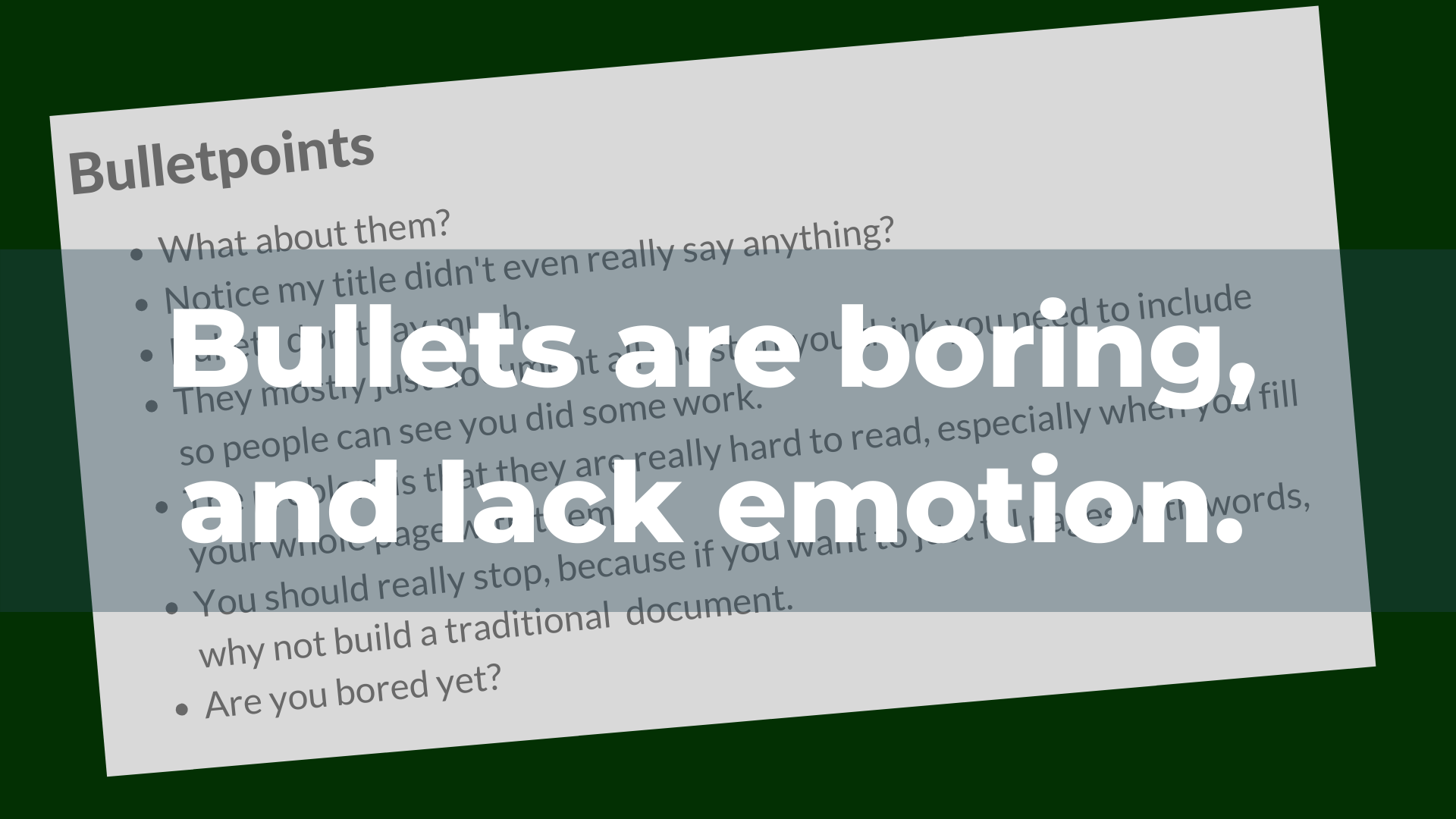powerpoint技巧
Almost 20 years ago — 2001! — Seth Godin wrote an ebook called Really Bad Powerpoint (and how to avoid it). In that book he detailed all of the things that tend to go wrong in slide presentations.
差不多20年前-2001年! —塞斯·戈丁(Seth Godin)寫了一本名為《 真的很糟糕的Powerpoint》 (以及如何避免它)的電子書。 在那本書中,他詳細介紹了幻燈片演示中容易出錯的所有方面。
Everyone creates presentations with the right intent — to communicate something of importance to a group of people. But then we do all sorts of dumb things to undermine their communication, don’t we? Like jamming it with bullet points so it can serve as a teleprompter, or throwing in every factoid we’ve learned about the topic to anticipate (and ward off) questions. Sometimes we want to manage or even mitigate conversation. And sometimes, we create them simply because we were told that we should.
每個人都有正確的意圖創建演示文稿-與一群人交流重要的事情。 但是,然后我們做各種愚蠢的事情來破壞他們的交流,不是嗎? 就像用項目符號將其塞住一樣,它可以用作提詞提示器,或者將我們已經學習過的有關該主題的所有擬事實扔進去,以預測(并避開)問題。 有時我們想管理甚至減輕對話。 有時,我們創建它們的原因僅僅是因為我們被告知我們應該這樣做。
On the very first page of Godin’s ebook, he says “Almost every PowerPoint presentation sucks rotten eggs.” And that was nineteen years ago!
他在Godin電子書的第一頁上說:“ 幾乎每個PowerPoint演示文稿都爛蛋。 ”那是19年前!
Here we are in 2020 and PowerPoint is just as prevalent as it was in 2001 and yet, for the most part, presentations have not gotten better. There are companies that have tried to help people make better presentations. Keynote was made specifically for Steve Jobs keynote presentations. Haiku Deck encouraged folks to remember that ‘less is more’, followed quickly by Prezi which seemed like a revelation for a moment in time — encouraging people to take their audience on a journey on an infinite canvas. All of these were born from the right intent — make better slides so you can tell better stories. In other words, get people to communicate better, and to create slides that don’t suck.
現在是2020年,PowerPoint與2001年一樣流行,但是在大多數情況下, 演示文稿并沒有變得更好 。 有些公司試圖幫助人們做出更好的演示。 主題演講專門針對史蒂夫·喬布斯的主題演講。 Haiku Deck鼓勵人們記住“少即是多”,緊隨其后的是Prezi,這似乎是一段時間內的一次啟示-鼓勵人們在無限的畫布上帶動觀眾。 所有這些都是出于正確的意圖而生的–制作更好的幻燈片,以便您講更好的故事。 換句話說,讓人們更好地溝通,并制作不會吸引人的幻燈片。

So what’s the problem? Because in most cases, Powerpoints continue to be uninspired, boring artifacts of the work, work, work. In fact, if you’ve spent any time in a sprawling corporate environment with layers upon layers of management, you’re probably very familiar with ‘rounds of revision’. We create our slides, and then revise, revise, revise as each member of the audience spends valuable time trying to tell you how to say it the way they would say it before it gets kicked on down the line. It can make it feel like your job is PowerPoint rather than thing that PowerPoint is supposed to communicate.
所以有什么問題? 因為在大多數情況下,Powerpoint仍然不受啟發,是工作,工作,工作的無聊產物 。 實際上,如果您花了很多時間在龐大的企業環境中,并進行了層層管理,那么您可能對“輪次修訂”非常熟悉。 我們創建幻燈片,然后修改,修改,修改,因為觀眾的每個成員都花費寶貴的時間試圖告訴您如何用他們說的方式說出來,然后才能開始。 它會讓您覺得您的工作是PowerPoint,而不是PowerPoint應該傳達的東西。
We can do better.
我們可以做得更好。

大多數幻燈片演示應具有變革性,但它們都是事務性的。 (Most slide presentations are transactional when they should be transformational.)
Slide presentations are meant to help us communicate. They shouldn’t be simply a container for facts and figures. They have the power to change how we understand the world, our companies, and our work. They can illuminate problems, and how we might solve them. They can inspire, instruct, and persuade action. But far too often, we forget to infuse the presentation with the emotion that we feel as we’re preparing it.
幻燈片演示文稿旨在幫助我們進行交流。 它們不應僅僅是事實和數據的容器。 他們有權改變我們對世界,我們的公司和我們的工作的了解 。 它們可以闡明問題以及我們如何解決它們。 他們可以激發,指導和說服行動。 但是很多時候,我們忘了給演示文稿注入準備時的感覺。
Here’s what Seth Godin pointed out in 2001 that was lost on most people. We have two sides of our brain. One (the left side) is the rules-based, rational side. The other (the right side) is the creative, emotional side. The reason we have two sides is because we need both to survive. We need both logic and emotion. Logic discerns there is a lion lurking in the brush; emotion says, ‘freeze, don’t flee!’. We need both logic and emotion in life, and we need them both in our presentation slides too. Here’s how you can do that.
塞斯·戈丁(Seth Godin)在2001年指出的這一點對大多數人來說是迷路的。 我們的大腦有兩個方面 。 一個(左側)是基于規則的理性方面 。 另一面(右側)是創造力,情感方面 。 我們有兩個方面的原因是因為我們都需要生存。 我們需要邏輯和情感。 邏輯發現刷子中潛伏著一只獅子。 情感說:“凍結,不要逃跑!”。 生活中我們既需要邏輯又需要情感, 在演示幻燈片中我們也需要邏輯和情感。 這是您可以執行的操作。

使用視覺效果刺激情緒。 (Use visuals to stimulate emotion.)
But first, let’s think about why slide presentations exist in the first place. Why not a plain old document? And why the horizontal orientation?
但是首先,讓我們考慮一下為什么幻燈片演示首先存在。 為什么不使用普通的舊文件? 以及為什么水平方向?
When slide software was invented, slides were intended to be viewed more like photographs which, before the smartphone, were almost always in a 4x3 (4 wide by 3 high) orientation. They were literal slides in a slide carousel that projected onto screens. Now you’ll often see 16x9 slides — wide format. And still, some folks can’t take the hint. They will fill that panorama with words and sentences so wide that you practically have to turn your head left to right repeatedly like a tennis umpire perched in her chair.
當發明了幻燈片軟件時,幻燈片的觀看目的更像是照片,在智能手機之前,幻燈片幾乎總是以4x3(4寬x 3高)的方向放置。 它們是投影在屏幕上的幻燈片輪播中的文字幻燈片 。 現在,您將經常看到16x9幻燈片-寬幅。 仍然,有些人無法接受提示。 他們將在寬廣的全景圖中填充如此廣泛的單詞和句子,以至于您幾乎不得不反復地左右搖頭,就像坐在椅子上的網球裁判一樣。

Now think. What are screens used for in virtually every other context? Stories! Visual stories.
現在想想。 幾乎在所有其他情況下,屏幕都有什么用? 故事! 視覺故事。
Okay, so what exactly should you be doing with your slides? What does a ‘homerun’ slide presentation look like? Here’s what Seth Godin said:
好的,那么您應該如何使用幻燈片? “本壘打”幻燈片演示是什么樣的? 這是塞思·戈丁(Seth Godin)所說的:
The home run is easy to describe: You put up a slide. It triggers an emotional reaction in the audience. They sit up and want to know what you’re going to say that fits in with that image. Then, if you do it right, every time they think of what you said, they’ll see the image (and vice versa).
本壘打很容易描述:您放了一張幻燈片。 它引起觀眾的情緒React 。 他們坐起來,想知道你要說的是什么與那個形象吻合。 然后,如果您做對了,每當他們想到您說的內容時,他們都會看到圖像 (反之亦然) 。
If you want to see how to do this really really well, just look to children's books.
如果您想真正真正地做到這一點,請閱讀兒童讀物。
The Cat In The Hat
帽子里的貓
- The Giving Tree 給樹
- Winnie the Pooh 維尼熊
- Where The Wild Things Are 野外之物

If you’ve read any of those books, and chances are you have, what did you conjure up just now? Pictures. Your memory just flooded your mind with images to help you access the content of the book. Children’s books could teach us all something about presenting. Some of the most memorable children’s books are lean on words and big on visuals. The story is told in clear and simple language with visuals that provide a jumping off point into your own imagination. And there’s another thing. You felt something too, didn’t you?
如果您已閱讀其中任何一本書,并且有機會,您剛才想到了什么? 圖片。 您的記憶力充斥著圖像,以幫助您訪問本書的內容。 兒童讀物可以教給我們有關展示的所有知識。 一些最令人難忘的兒童讀物偏向于文字,而視覺效果卻很大。 故事以清晰明了的語言講述, 并帶有視覺效果 ,使您跳入自己的想象空間。 還有另一件事。 你也有感覺,不是嗎?
In a research study published in Frontiers in Psychology about the link between emotions and memory, one research team found that “Emotion has a substantial influence on the cognitive processes in humans, including perception, attention, learning, memory, reasoning, and problem solving.”* Another team at MIT found that “memory improves when they are shown a higher percentage of memorable images.”* And, in the only study I could find specifically about presentation visuals, the researchers concluded that “Perceptions of the presenter as well as audience attention, comprehension, yielding, and retention are enhanced when presentation support (imagery) is used compared to when it is not. Presentations using visual aids were found to be 43% more persuasive than unaided presentations.”
在《 心理學前沿》上發表的一項關于情緒與記憶之間聯系的研究中,一個研究小組發現:“情緒對人類的認知過程具有重大影響,包括感知,注意力,學習,記憶,推理和解決問題的能力。 ” *麻省理工學院的另一個團隊發現,“當向人們展示更高比例的令人難忘的圖像時,記憶會有所改善。” *而且,在我可以專門找到的有關演示視覺效果的唯一研究中 ,研究人員得出的結論是:“與演示支持相比,使用演示支持( 圖像 )可以提高演示者的感知以及觀眾的注意力,理解力,屈服力和保留力”不是。 發現使用視覺輔助工具的演示比沒有輔助的演示更有說服力43%。 ”
使用講故事進行說服并促使人們采取行動。 (Use storytelling to persuade and get people to take action.)
But using visuals isn’t the whole story. In fact, to be effective in a presentation you must tell a story. Visuals are simply the mind’s container that will make that story memorable. To tell a great story, you need a basic story structure. And what is a story exactly? A story is the narration of a journey from some place to another. It’s a telling of a sequence of events that lead you from one stop on the journey to the next. And that’s what you need to capture in your presentation. What journey are you taking your audience on? A quick and easy way to set up a story is with this 3-part story structure.
但是,使用視覺效果并不是全部。 實際上,要使演示文稿有效,您必須講一個故事。 視覺僅僅是頭腦的容器,它將使這個故事令人難忘。 要講述一個偉大的故事,您需要一個基本的故事結構。 故事到底是什么? 故事是從某個地方到另一個地方的敘述。 這說明了一系列事件,這些事件導致您從旅程的下一站到下一站。 這就是您需要在演示文稿中捕獲的內容。 您是如何帶領觀眾的? 通過一個三部分的故事結構 ,可以快速輕松地建立故事。
Context — What’s the situation now? What’s the ‘current state’ and if needed, the background on how you got here. Ex. Our sales suck, and we need to fix that.
上下文 -現在情況如何? 什么是“當前狀態”,如果需要的話,還有您到達這里的背景。 例如 我們的銷售不好,我們需要解決這個問題。
Complication — What’s stopping you (or your audience) from moving forward? What is the obstacle? Is it an external villain (ex. Our competition is eating our lunch because . . . ); or is it something more nefarious (ex. The processes we’ve put in place have become so convoluted we’re spending more time managing our processes than creating a great product.)
并發癥 -是什么在阻止您(或您的聽眾)前進? 有什么障礙? 是外部的惡棍嗎(例如, 我們的競爭是因為 …… 而吃了午餐 ); 還是更邪惡(例如,我們已經建立的流程變得如此復雜,我們花費更多的時間來管理流程,而不是創造出出色的產品。)
Resolution — What do you suggest doing about it?
解決方法 –您對此有何建議?

提出要求。 (Make the ask.)
One of the silliest mistakes that people make when giving presentations is wrapping things up before making a request. Think about why you’re there. Is it to ask for funding, get agreement on the next step of a project, get political buy-in on a new initiative, to point out a problem that is worth solving? You absolutely must get very clear about what it is that you want from your audience. If you didn’t need anything from them, there wouldn’t be a presentation in the first place. Sometimes you have an explicit ‘call to action’ (CTA), and sometimes it’s more nuanced.
人們在做演示時犯的最嚴重的錯誤之一就是在提出請求之前先將其包裝好。 想想你為什么在那里。 是要尋求資金,就項目的下一步達成協議,就一項新倡議獲得政治支持,還是要指出一個值得解決的問題? 您絕對必須非常清楚觀眾想要什么 。 如果您不需要他們提供任何幫助,那么首先不會進行演示。 有時您會有明確的“號召性用語”(CTA),有時則更為細微。
Explicit: ‘We need your approval to move this project to the next step.” Do you approve?
明確: “我們需要您的批準才能將該項目移至下一步。” 你贊成嗎
Implicit: If we don’t solve this problem, this project will take twice as long as it should. Do you want me to tell you how to solve the problem? Or Do you want to divert resources to solving the problem?
隱式: 如果我們不解決此問題,則該項目將花費應有時間的兩倍。 您要我告訴您如何解決問題嗎? 要么 您是否要轉移資源來解決問題?
If there isn’t an opening for a discussion, why go through the effort of assembling an audience? Create that opening by making your ask. It could be as simple as ‘is this in line with your expectations?’
如果沒有討論的余地,為什么還要努力吸引觀眾呢? 通過提出要求來創建該開口。 可能很簡單,例如“這符合您的期望嗎?”

That request is really an invitation, and it’s all about taking your presentation from transactional to transformational. If you get good at this, you may well find that you’ve even transformed your audience’s perception of you into someone they can’t do without.
該請求實際上是一個邀請 ,而這一切都是關于將您的演示文稿從事務性轉變為變革性的。 如果您擅長于此,那么您可能會發現自己甚至已經將聽眾對您的看法轉變為他們離不開的人。
結語 (Wrapping Up)
Next time you sit down to prepare some slides, ask yourself:
下次您坐下來準備一些幻燈片時,請問自己:
What do I have to say and why should they care? Get in touch with that before you start banging the keys.
我要說什么,他們為什么要關心呢? 開始敲鍵之前,請與您取得聯系。
Now, what do you want them to feel? Notice the pictures that come to mind, or maybe doodle a few to activate that part of your brain. Pretend you’re writing a children’s book.
現在, 您希望他們有什么感覺? 請注意出現的圖片,或者涂鴉一些以激活大腦的該部分。 假設您正在寫兒童讀物。
Now, without writing a novel, jot down the context, complication, and resolution. You should easily be able to get each on a sticky note.
現在,不用寫小說,記下上下文,復雜性和解決方案 。 您應該可以輕松地將每個粘貼在便箋上。
Finally, what are you asking for? Don’t forget to make your ask and get an answer.
最后, 您要什么? 不要忘記提出您的要求并得到答案。
Here’s the whole thing in a quickie deck I made in Canva.
這是我在Canva制作的快速裝甲板中的全部內容。
Got all that done? Now you’re ready to start making a presentation that is less likely to suck. And if you can’t do that, think about rescheduling the meeting.
完成所有這些了嗎? 現在,您可以開始進行不太可能吸引人的演示了。 如果您做不到,請考慮重新安排會議時間。
If all you want to do is create a file of facts and figures, then cancel the meeting and send in a report. — Seth Godin.
如果您要做的只是創建事實和數據文件,則取消會議并發送報告。 塞斯·戈丁(Seth Godin)。
翻譯自: https://uxdesign.cc/almost-every-powerpoint-sucks-rotten-eggs-24d806156bf0
powerpoint技巧
本文來自互聯網用戶投稿,該文觀點僅代表作者本人,不代表本站立場。本站僅提供信息存儲空間服務,不擁有所有權,不承擔相關法律責任。 如若轉載,請注明出處:http://www.pswp.cn/news/275873.shtml 繁體地址,請注明出處:http://hk.pswp.cn/news/275873.shtml 英文地址,請注明出處:http://en.pswp.cn/news/275873.shtml
如若內容造成侵權/違法違規/事實不符,請聯系多彩編程網進行投訴反饋email:809451989@qq.com,一經查實,立即刪除!


)




:Silverlight的界面布局)






)


)
